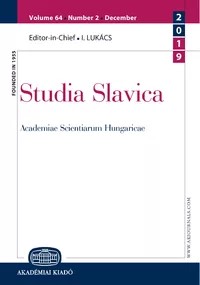Итоги работы по созданию Электронного исторического словаря заимствованной лексики в русском языке XI–XVII вв. Часть вторая: полонизмы
Results of the Compilation of the Electronic Historical Dictionary of Loan-Words in the Russian Language of the 11th–17th centuries Part Two: Polonisms
Author(s): Maria Olegovna Novak , Yana PenkovaSubject(s): Historical Linguistics, Eastern Slavic Languages
Published by: Akadémiai Kiadó
Keywords: historical lexicography; historical lexicology; e-dictionary; language contacts; Russian language; Polish language; Ruthenian language; lexical borrowings; mediating language;
Summary/Abstract: This part of the review is devoted to the Polonisms section. The paper discusses the general dictionary concept and vocabulary selection principles. The Polonisms section includes lexical borrowings both from the Polish language and through Polish from other, predominantly European languages and through the Ruthenian language. The structure of a dictionary entry involves both traditional vocabulary areas, such as grammatical information, interpretation, illustrating quotations and references to sources, and areas specially provided for the historical dictionary of borrowings: phonetic and morphological variants of loan-words adaptation, hapax legomena indication, etymological references, taking into account the route of borrowing, Polish as an intermediary language indication, first fixation sources’ character. The sources used in the dictionary, vocabulary volume, and the chronology of lexical borrowings starting from the earliest fixations are characterized. The article pays special attention to the work with etymological dictionaries and etymological issues in general. It also estimates the role of Polish as both a source and intermediary language through which Russian assimilates European vocabulary, taking into account repeated borrowings previously loaned directly from Greek and in the Mid-Russian period borrowed through Polish again. The etymology of certain loan words is clarified, the problem of Ruthenisms and prostaya mova as another intermediary source of loan Polonisms is highlighted. The article discusses patterns of phonetic and morphological adaptation of Polish vocabulary and demonstrates, according to the dictionary materials, some semantic clarifications and additions to the list of semantic Polonisms. It also highlights the dictionary’s capabilities as a source of additional historical, lexicographical, philological, and cultural information. Considering the thematic stratification of borrowed vocabulary, the authors indicate the most numerous thematic groups of Polonisms. In the paper’s conclusion, the prospects of further improvement of the dictionary and its whole concept for Russian historical lexicography are evaluated.
Journal: Studia Slavica Academiae Scientiarum Hungaricae
- Issue Year: 68/2023
- Issue No: 1-2
- Page Range: 317-334
- Page Count: 18
- Language: Russian
- Content File-PDF

